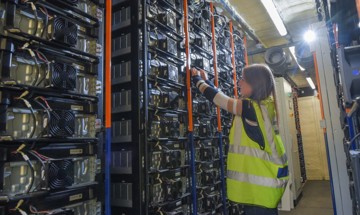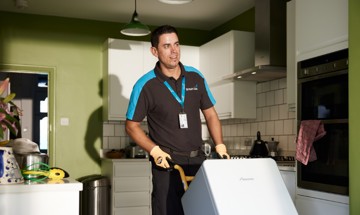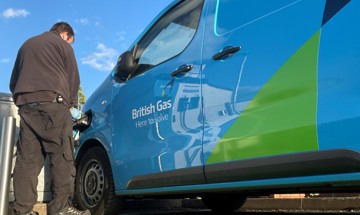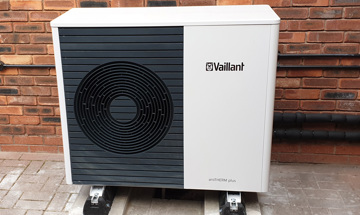An electric car charging on your drive could become an extension of your home energy system. As the distinct worlds of energy and automotive converge, we ask some of the leading voices in those sectors about the future for their industry, and how the changes will impact consumers.
For generations of British drivers, petrol or diesel has been the only viable option for fuelling their cars. That’s changing fast as the technology behind electric vehicles (EVs) improves and drivers respond to the Government’s ban on the sale of petrol and diesel cars by 2030.
Transport accounts for almost a third of UK carbon dioxide emissions and the environmental benefits of EVs are well documented. In addition to being good for the planet in terms of reducing exhaust emissions, widescale EV adoption could allow the batteries that power them to play a key role in the transformation to a net zero energy system.
It will require a lot of EVs to make that happen, but the migration to electric cars is already gaining momentum among British drivers. Plug-in car sales – including fully electric and hybrid vehicles – accounted for almost 14% of UK automotive sales in the spring of 2021, up from 7% the previous year.
As costs come down and the charging infrastructure is strengthened, consumer confidence in EVs is likely to grow further, according to Graeme Cooper, Head of Future Markets at National Grid. Greater uptake will move the game-changing potential of EVs beyond reducing on-road emissions, he explains.
That’s because these vehicles can be integrated into AI-enabled home systems to usher in a new era of efficient energy management.


Charging forwards
The more EVs we have on the road, the more energy we’ll need to power them.
Energy consumption is set to more than double by 2050 as electrification increases, according to research from McKinsey. And to meet net zero targets, renewables will need to play an increasingly dominant role in the energy mix.
It’s a future in which consumers can play a role. We can contribute to the energy transition by adopting smart home energy management technology, such as solar panels, EV charging points and smart apps. This will enable us to monitor, manage and optimise our energy consumption day and night. A single app could potentially control both energy use and heating either manually or automatically, reducing reliance on the grid.
To maximise the use of clean power, smart energy systems can ensure car batteries are charged when supply from renewable sources is abundant. To cut costs, car batteries can be charged during off-peak hours when power is cheapest. When there is additional demand, such as during the half-time break in a big, televised football match, available energy can be diverted to ensure it is distributed where and when it is most needed.
While growing demand for electric vehicles adds to the problem of energy distribution, EVs can also form part of the solution. Once charged, excess energy stored in the car’s battery can be used to power your household needs or can be sold back into the grid.
"If we can smooth out demand, the whole energy system will work more efficiently"
Disruptive behaviour
Such a fundamental upgrade of our home energy ecosystems will demand behavioural changes from many consumers. Adding vehicles into the mix means that for the first time, people will be required to put some thought into how they manage their car, rather than just parking it and forgetting about it.
According to Stuart Rowley, President at Ford of Europe, it’s vital that the industry makes the transition straightforward to encourage mass EV adoption.
“The challenge is on us – the industry – to provide solutions that are better and remove the barriers to adoption,” he says.
The benefits of electrifying the transport sector and eventually heating systems, go beyond efficient home energy management. At the national level, automated systems help balance energy loads associated with a renewable energy-dominated grid – energy from renewable sources like wind or solar can’t be easily stored, so it’s generated on a use-it-or-lose-it basis.
“If we can smooth out demand, the whole energy system will work more efficiently,” says Cooper. “It allows us to balance the seesaw between making more power or consuming less power.”
While the upfront costs of buying an EV may seem high, over their lifespan they are less expensive to run than a petrol or diesel car. There are gains to be made from reducing home energy bills by plugging the car into home energy management systems, as well as giving the consumer greater understanding and control of their energy profile and usage.
On a larger scale, the surplus stored in the batteries of a fleet of electric cars could be used to power an office building, for example. But the technology to enable this dual use of energy needs to be affordable.
The costs of smart energy technology will certainly come down in the next five to ten years, serving as an additional motivation for investment, according to Tom Hart, Head of Portfolio for Energy Management and EV at Centrica.
“There’s definitely some opportunity, but we need to bring the cost down of the actual hardware and then find the right applications in various different scenarios,” he says.
“It’s just where that application will be – in the home versus a commercial setting – so it will be interesting to see how that plays out.”

Smart solutions
Technology from Centrica includes not only the charge points in homes, workplaces and public spaces, but also smart software that helps to make EV charging as efficient as possible.The company’s Hive EV charging solution combines hardware, software and an operating package to enable energy consumers to monitor and control how energy is distributed through a single app, for example.
“Crucially, it will enable you to smart charge, to pre-set when you need your car ready to go and set what’s happening in the background based on signals from the grid,” says Hart.
Centrica has partnered with a number of charge point operators, offering an extension of this system, which allows consumers to charge away from the home, refuelling at roadside sites while monitoring costs that are listed in one place.
The partnership between automotive companies, energy companies like Centrica and charging providers, is really going to be fundamental as we go through this transition, Rowley adds.
“No one of us will be able to do this ourselves, but as we drive down the cost of the technology it becomes accessible to everybody,” he says. “The whole connectivity experience through the lifecycle of the vehicle. The ecosystem is going to change dramatically.”
It’s clear that an electric car can be much more than a means of getting from A to B. It is a mobile battery that creates a tremendous degree of flexibility when it comes to how we use energy in the UK. As the way we generate and consume energy becomes increasingly integrated, convincing consumers of the importance of being part of a broader ecosystem will be central to our energy future.

Blog
Battery storage – the ying to renewables' yang
Tech & Innovation

Blog
The drive for Diversity in the UK Tech sector
Tech & Innovation

Blog
Hydrogen boilers will help us to reach net zero together
Tech & Innovation

Blog
Adapting to a Flexible First approach and the tech that will help us
Tech & Innovation

Case Study
Diary of a street charger – getting the most of an electric commercial vehicle
Tech & Innovation

Case Study
Will the hybrid heat pump help pave the way for a future of no gas?
Tech & Innovation


